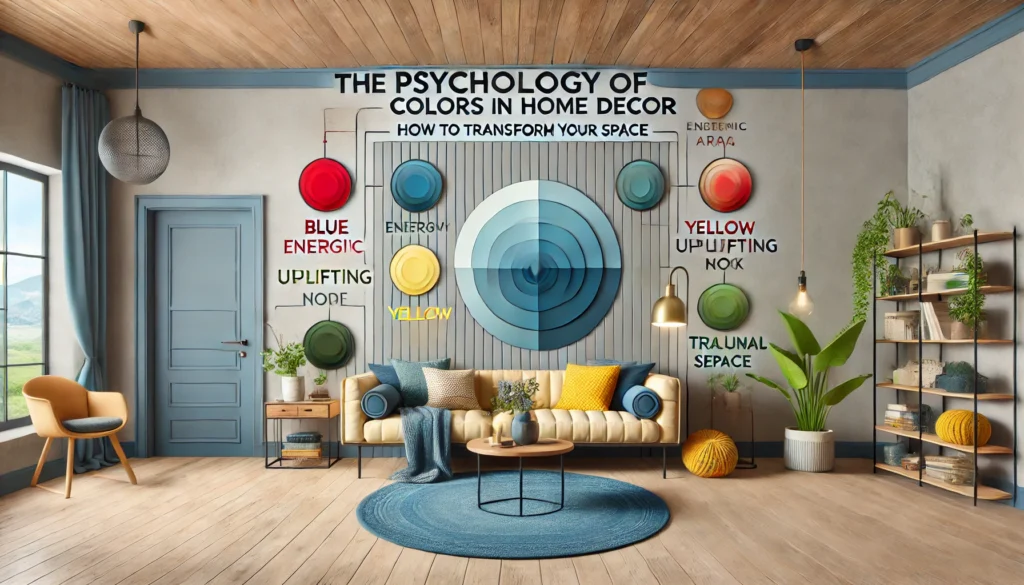
When designing a home, choosing the right colors is about more than just aesthetics. Colors have a powerful psychological impact, influencing our emotions, behavior, and even productivity. Whether you’re looking to create a calming retreat, an energizing workspace, or a welcoming living room, understanding color psychology can help you make informed decor choices. Let’s dive into how different colors affect mood and how you can use them effectively in your home decor.
1. Understanding Color Psychology in Interior Design
Color psychology is the study of how colors influence human emotions and behavior. Different shades can evoke different feelings, which is why selecting the right color for each room is crucial.
- Warm colors (red, orange, yellow) tend to be stimulating, energetic, and inviting.
- Cool colors (blue, green, purple) are calming, soothing, and relaxing.
- Neutral colors (white, beige, gray) provide balance and versatility.
By strategically using these colors, you can create a home environment that enhances well-being and reflects your personality.
2. How Different Colors Affect Mood
Each color has a unique psychological effect. Let’s explore how some of the most commonly used home decor colors impact emotions.
Red: Bold, Passionate, and Energizing
Red is a stimulating color that evokes passion, excitement, and warmth. It’s perfect for:
- Dining rooms – Increases appetite and encourages conversation.
- Living rooms – Creates an energetic and welcoming space.
- Bedrooms (use with caution) – Too much red can be overwhelming, but deep red accents can add a romantic touch.
Blue: Calming, Peaceful, and Productive
Blue is known for its ability to reduce stress and create a serene atmosphere. It’s ideal for:
- Bedrooms – Promotes relaxation and restful sleep.
- Bathrooms – Gives a fresh and clean feel.
- Home offices – Enhances focus and productivity.
Yellow: Cheerful, Bright, and Inviting
Yellow brings happiness and warmth, making it a great choice for:
- Kitchens – Encourages a lively and positive atmosphere.
- Entryways – Creates a welcoming first impression.
- Dining areas – Stimulates appetite and conversation.
Green: Refreshing, Balanced, and Soothing
Green represents nature and renewal, making it perfect for:
- Living rooms – Adds a sense of harmony and peace.
- Bedrooms – Encourages relaxation and balance.
- Workspaces – Boosts creativity and reduces stress.
Purple: Luxurious, Creative, and Mysterious
Purple is often associated with luxury, creativity, and spirituality. It’s great for:
- Bedrooms – Deep purples add sophistication, while lighter shades promote tranquility.
- Home offices – Encourages inspiration and innovation.
- Accent walls – Adds a touch of elegance.
Neutrals (White, Gray, Beige, and Black): Classic, Timeless, and Versatile
Neutral colors are essential in home decor as they provide balance and flexibility.
- White – Clean, fresh, and minimalistic. Perfect for any room.
- Gray – Elegant, modern, and sophisticated. Works well in living rooms and offices.
- Beige – Warm, cozy, and welcoming. Ideal for bedrooms and common areas.
- Black – Bold, dramatic, and stylish when used as an accent.
3. Choosing the Right Color Palette for Each RoomNow that we understand how colors affect mood, let’s explore how to choose the right color combinations for different spaces.
Living Room: Warm and Inviting
Best colors: Beige, warm gray, soft greens, and blues.
- These colors create a cozy and welcoming space for entertaining guests and relaxing.
Bedroom: Tranquil and Restful
Best colors: Soft blues, greens, lavenders, and neutral tones.
- These shades promote relaxation and improve sleep quality.
Kitchen: Energizing and Bright
Best colors: Yellow, white, and light blues.
- A vibrant kitchen encourages appetite and social interaction.
Bathroom: Fresh and Clean
Best colors: White, soft blues, and pastel greens.
- These colors create a spa-like, refreshing atmosphere.
Home Office: Focused and Productive
Best colors: Blue, green, and neutral tones.
- These colors boost concentration, reduce stress, and enhance creativity.
4. Using Color Psychology to Personalize Your Home
Your home should reflect your personality, and color psychology can help you achieve that. Here are some tips:
- Experiment with accents – If you’re hesitant about bold colors, try using them in pillows, rugs, or wall art.
- Consider lighting – Natural and artificial lighting can change how a color looks in a room.
- Use contrast for balance – Pair bold colors with neutrals to avoid overwhelming the space.
5. Conclusion: Transform Your Home with the Right Colors
Colors play a vital role in shaping the ambiance of your home. By understanding color psychology, you can create a space that not only looks beautiful but also enhances your mood and well-being. Whether you prefer calming blues, energizing reds, or cozy neutrals, the right color choices can make a world of difference in how your home feels.
Also Read:- Best Plywood for Kitchen Cabinets & Interiors – Expert Guide
1. What is the best color for a small room?
Lighter shades like white, beige, and pastels can make a small room feel more spacious and open.
2. Can I use dark colors in home decor?
Yes! Dark colors like navy blue or deep green can add depth and elegance when balanced with lighter tones and good lighting.
3. What color should I paint my home office for better productivity?
Blue and green are excellent choices as they promote focus, reduce stress, and boost creativity.
4. How can I test a color before painting my walls?
Use paint samples on a small section of your wall and observe how they look in different lighting throughout the day.
5. Which color is best for a relaxing bedroom?
Soft blues, greens, and lavenders are known for their calming effects and are ideal for a restful bedroom atmosphere.